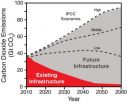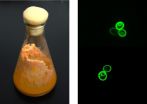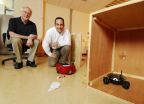(Press-News.org) Five minutes in a scanner can reveal how far a child's brain has come along the path from childhood to maturity and potentially shed light on a range of psychological and developmental disorders, scientists at Washington University School of Medicine in St. Louis have shown.
Researchers assert this week in Science that their study proves brain imaging data can offer more extensive help in tracking aberrant brain development.
"Pediatricians regularly plot where their patients are in terms of height, weight and other measures, and then match these up to standardized curves that track typical developmental pathways," says senior author Bradley Schlaggar, MD, PhD, a Washington University pediatric neurologist. "When the patient deviates too strongly from the standardized ranges or veers suddenly from one developmental path to another, the physician knows there's a need to start asking why."
Schlaggar and his colleagues say a new way of looking at brain scanning data may be able to provide similar guidance for monitoring and treating of patients with psychiatric and developmental disorders.
Schlaggar, the A. Ernest and Jane G. Stein Associate Professor of Neurology, says he has sent children with obvious, profound psychiatric conditions for MRI scans and received results marked "no abnormalities noted."
"That's typically looking at the data from a structural point of view—what's different about the shapes of various brain regions," he says. "But MRI also offers ways to analyze how different parts of the brain work together functionally."
Compare functional data to standardized models of how brain function or disease normally develops, Schlaggar says, and a range of new clinical insights becomes available.
Schlaggar and his colleagues use an approach to brain scanning called resting state functional connectivity. By correlating increases and decreases in blood flow to the various brain regions as subjects rest in the scanner, scientists determine which of these regions work together in brain networks.
In a study published in 2009, Washington University scientists showed that as the brain matures, these brain networks change (see http://news.wustl.edu/news/Pages/14199.aspx). The overall organization switches from networks involving regions physically close to each other, which is the dominant motif in a child's brain, to networks that connect distant regions, the primary organizational principal in adult brains.
For the new study, lead author Nico Dosenbach, MD, PhD, a pediatric neurology resident at St. Louis Children's Hospital, took this and other distinctions that mark the transition from child to adult brain and adapted them for use in a technique for mathematical analysis called a support vector machine. The technique is employed in many contexts in science and economics and on the Internet.
"It's a way that mathematicians have developed for predicting something with high specificity and sensitivity when you have huge amounts of data instead of one really good measurement," Dosenbach explains. "Any one of these measurements doesn't tell you much, but if you put them together and use the right math to sift through and restructure them, you can get good predictive results."
Dosenbach used data from five-minute MRI scans of 238 normal subjects ranging in age from 7 to 30. The support vector machine analyzed approximately 13,000 functional brain connections and selected the best 200 produce a single index of the maturity of each subject. The data allowed scientists to predict whether subjects were children or adults, and roughly formed a curving line that tracks the path of normal functional brain development.
The researchers suspect patients with brain disorders will appear out of alignment with this normal developmental curve.
"The beauty of this approach is that it lets you ask what's different in the way that children with autism, for example, are off the normal development curve versus the way children with attention-deficit disorder are off that curve," Schlaggar says.
Schlaggar suggests that functional brain scans might be conducted on a group of children at risk but not yet suffering from a developmental disorder.
"When a fraction of them later develop that disorder, you can go back and construct an analysis like this one that will help predict the characteristics of the next child at highest risk of developing the disorder," he says. "That's very powerful both clinically and from the perspective of understanding the causes of these disorders."
This approach might enable treatment prior to onset of symptoms, Schlaggar says, and should help physicians more quickly and closely track the results of clinical trials of new therapies.
"MRI scans are expensive, so this may not be what we use for everyone right now," Dosenbach says. "But many children with these types of disorders already receive regular structural MRI scans, and five more minutes in the scanner won't add that much to the cost."
###
Dosenbach NUF, Nardos B, Cohen AL, Fair DA, Power JD, Church JA, Nelson SM, Wig GS, Vogel AC, Lessov-Schlaggar CN, Barnes KA, Dubis JW, Feczko E, Coalson RS, Pruett JR JR, Barch DM, Petersen SE, Schlaggar BL. Prediction of individual brain maturity using fMRI. Science, Sept. 10, 2010.
Funding from the National Institutes of Health, the John Merck Scholars Fund, the Burroughs-Wellcome Fund, the Dana Foundation, the Ogle Family Fund, the McDonnell Center, the Simons Foundation, the American Hearing Research Foundation, and the Diabetes Research Center at Washington University supported this research.
Washington University School of Medicine's 2,100 employed and volunteer faculty physicians also are the medical staff of Barnes-Jewish and St. Louis Children's hospitals. The School of Medicine is one of the leading medical research, teaching and patient care institutions in the nation, currently ranked fourth in the nation by U.S. News & World Report. Through its affiliations with Barnes-Jewish and St. Louis Children's hospitals, the School of Medicine is linked to BJC HealthCare.
END
Stanford, CA— Scientists have warned that avoiding dangerous climate change this century will require steep cuts in carbon dioxide emissions. New energy-efficient or carbon-free technologies can help, but what about the power plants, cars, trucks, and other fossil-fuel-burning devices already in operation? Unless forced into early retirement, they will emit carbon dioxide into the atmosphere for decades to come. Will their emissions push carbon dioxide levels beyond prescribed limits, regardless of what we build next? Is there already too much inertia in the system to curb ...
Laxenburg, Austria – 9th September 2010. Due to increasing life-spans and improved health many populations are 'aging' more slowly than conventional measures indicate.
In a new study, to be published in Science, (10 September) scientists from the International Institute for Applied Systems Analysis (IIASA) in Austria, Stony Brook University, US, (SBU), and the Vienna Institute of Demography (VID) have developed new measures of aging that take changes in disability status and longevity into account.
The results give policymakers faced with growing numbers of elderly ...
Current energy technologies are not enough to reduce carbon emissions to a level needed to lower the risks associated with climate change, New York University physicist Martin Hoffert concludes in an essay in the latest issue of the journal Science.
Many scientists have determined that in order to avoid the risks brought about by climate change, steps must be taken to prevent the mean global temperature from rising by more than 2°C above pre-industrial levels. Current climate models indicate that achieving this goal will require limiting atmospheric carbon dioxide (CO2) ...
An innovative grouping of conservation scientists and practitioners have come together to advocate a fundamental shift in the way we view biodiversity. In their paper, which was published today in the journal Science, they argue that unless people recognise the link between their consumption choices and biodiversity loss, the diversity of life on Earth will continue to decline.
Dr Mike Rands, Director of the Cambridge Conservation Initiative and lead author of the paper, said: "Despite increasing worldwide conservation efforts, biodiversity continues to decline. If ...
The lure of greater profits elsewhere in the world may divert bio-pharmaceutical firms in developing countries from the creation and distribution of affordable drugs, vaccines and diagnostics for illnesses of local concern, undermining the health prospects of millions of poor people, experts warn.
And they call for a series of measures to bolster international support for continuing the success of firms finding homegrown solutions to immediate health concerns in developing countries.
In a commentary published by the journal Nature Biotechnology, researchers Rahim Rezaie ...
University of California, Berkeley, researchers have taken genes from grass-eating fungi and stuffed them into yeast, creating strains that produce alcohol from tough plant material – cellulose – that normal yeast can't digest.
The feat could be a boon for the biofuels industry, which is struggling to make cellulosic ethanol – ethanol from plant fiber, not just cornstarch or sugar – economically feasible.
"By adding these genes to yeast, we have created strains that grow better on plant material than does wild yeast, which eats only glucose or sucrose," said Jamie Cate, ...
NAIROBI (9 September 2010)—Greenhouse gas emissions caused by livestock operations in tropical countries—a major contributor to climate change—could be cut significantly by changing diets and breeds and improving degraded lands, according to a new study published this week in the U.S. Proceedings of the National Academy of Sciences. And as an added bonus, scientists found the small changes in production practices could provide a big payoff by providing poor farmers with up to US$1.3 billion annually in payments for carbon offsets.
"These technologically straightforward ...
Liquid water has interacted with the Martian surface throughout Mars' history, measurements by NASA's Phoenix Mars Lander suggest.
The findings, published in the Sept. 10 issue of the journal Science, also suggest that liquid water has primarily existed at temperatures near freezing, implying hydrothermal systems similar to Yellowstone's hot springs on Earth have been rare on Mars throughout its history.
These surprising results come from measurements Phoenix made in 2008 of stable isotopes of carbon and oxygen in the carbon dioxide of the Martian atmosphere. Isotopes ...
URBANA – In the search for the perfect crop for biofuel production, Miscanthus has become the darling to many. But in an effort to not be charmed by its enormous potential for biomass production, researchers at the University of Illinois are taking a careful look at the pros and cons of its behavior in the field.
A recent study analyzed water quantity and quality in plots of Miscanthus, switchgrass, corn, and soybeans and found that Miscanthus used substantially more water, but reduced the potential for nitrogen pollution to water bodies.
"We found that Miscanthus ...
A robot deceives an enemy soldier by creating a false trail and hiding so that it will not be caught. While this sounds like a scene from one of the Terminator movies, it's actually the scenario of an experiment conducted by researchers at the Georgia Institute of Technology as part of what is believed to be the first detailed examination of robot deception.
"We have developed algorithms that allow a robot to determine whether it should deceive a human or other intelligent machine and we have designed techniques that help the robot select the best deceptive strategy to ...





